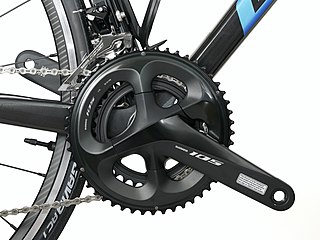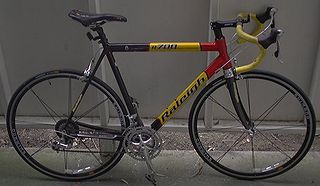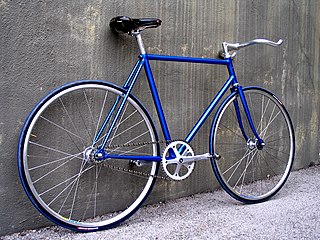
A hub gear, internal-gear hub, internally geared hub or just gear hub is a gear ratio changing system commonly used on bicycles that is implemented with planetary or epicyclic gears. The gears and lubricants are sealed within the shell of the hub gear, in contrast with derailleur gears where the gears and mechanism are exposed to the elements. Changing the gear ratio was traditionally accomplished by a shift lever connected to the hub with a Bowden cable, and twist-grip style shifters have become common.
Shimano, Inc. is a Japanese multinational manufacturer of cycling components, fishing tackle and rowing equipment. It produced golf supplies until 2005 and snowboarding gear until 2008. Headquartered in Sakai, Japan, the company has 32 consolidated subsidiaries and 11 unconsolidated subsidiaries. Shimano's primary manufacturing plants are in Kunshan, China; Malaysia; and Singapore.
Campagnolo is an Italian manufacturer of bicycle components with headquarters in Vicenza, Italy. The components are organised as groupsets (gruppi), and are a near-complete collection of a bicycle's mechanical parts. Campagnolo's flagship components are the Super Record, Record, and Chorus groupsets with all three representing their recent shift to 12-speed drivetrains. Super Record and Record are the top groupsets, followed by Chorus, Potenza, Centaur and Veloce. Campagnolo also produces aluminum and carbon wheels, as well as other components.

The crankset or chainset, is the component of a bicycle drivetrain that converts the reciprocating motion of the rider's legs into rotational motion used to drive the chain or belt, which in turn drives the rear wheel. It consists of one or more sprockets, also called chainrings or chainwheels attached to the cranks, arms, or crankarms to which the pedals attach. It is connected to the rider by the pedals, to the bicycle frame by the bottom bracket, and to the rear sprocket, cassette or freewheel via the chain.

A bicycle chain is a roller chain that transfers power from the pedals to the drive-wheel of a bicycle, thus propelling it. Most bicycle chains are made from plain carbon or alloy steel, but some are nickel-plated to prevent rust, or simply for aesthetics.
A groupset or gruppo is a bicycle component manufacturer's organized collection of mechanical parts. It generally refers to all of the components that make up a bicycle excluding the bicycle frame, fork, stem, wheels, tires, and rider contact points, such as the saddle and handlebars.

A racing bicycle, also known as a road bike, and once popularly known as a ten speed, is a bicycle designed for competitive road cycling, a sport governed by and according to the rules of the Union Cycliste Internationale (UCI). The UCI rules were altered in 1934 to exclude recumbent bicycles.

A single-speed bicycle is a type of bicycle with a single gear ratio. These bicycles are without derailleur gears, hub gearing or other methods for varying the gear ratio of the bicycle.

A fixed-gear bicycle is a bicycle that has a drivetrain with no freewheel mechanism. The freewheel was developed early in the history of bicycle design but the fixed-gear bicycle remained the standard track racing design. More recently the "fixie" has become a popular alternative among mainly urban cyclists, offering the advantage of simplicity compared with the standard multi-geared bicycle.
SRAM LLC is a privately owned bicycle component manufacturer based in Chicago, Illinois, United States, founded in 1987. SRAM is an acronym comprising the names of its founders, Scott, Ray, and Sam,. The company is known for producing cycling components, including some internally developed, such as Grip Shift, EAGLE (1x12), DoubleTap, dedicated 1x11 mountain and road drivetrains and SRAM Red eTap.
SunTour (Maeda) was the most important Japanese manufacturer of bicycle components based in Osaka until 1988, when Sakae Ringyo Company, a major Japanese maker of aluminum parts, particularly cranks and seat posts, bought what was left of the bankrupt SunTour, and the combined companies are now known as SR-SunTour. SunTour reached a zenith of sales and commercial success from the late 1970s to the mid-1980s. Its products range from suspension forks to derailleurs.

On a bicycle, the cogset or cluster is the set of multiple sprockets that attaches to the hub on the rear wheel. A cogset works with a rear derailleur to provide multiple gear ratios to the rider. Cogsets come in two varieties, freewheels or cassettes, of which cassettes are a newer development. Although cassettes and freewheels perform the same function and look almost the same when installed, they have important mechanical differences and are not interchangeable.

A bicycle shifter or gear control or gear levers is a component used to control the gearing mechanisms and select the desired gear ratio. Typically, they operate either a derailleur mechanism or an internal hub gear mechanism. In either case, the control is operated by moving a cable that connects the shifter to the gear mechanism.

Bicycle gearing is the aspect of a bicycle drivetrain that determines the relation between the cadence, the rate at which the rider pedals, and the rate at which the drive wheel turns.

Hyperglide is the name given by cycling component manufacturer Shimano to a sprocket design in their bicycle derailleur tooth cassette systems. It varies gear tooth profiles, and/or pins along the faces of freewheel or cassette sprockets, or between the chainrings in a crankset, to ease shifting between them.

A belt-driven bicycle is a chainless bicycle that uses a toothed synchronous belt to transmit power from the pedals to the wheel.

An electronic gear-shifting system is a method of changing gears on a bicycle, which enables riders to shift with electronic switches instead of using conventional control levers and mechanical cables. The switches are connected by wire or wirelessly to a battery pack and to a small electric motor that drives the derailleur, switching the chain from cog to cog. An electronic system can switch gears faster, and because the system does not use Bowden cables and can calibrate itself, it may require less maintenance.

Bicycle drivetrain systems are used to transmit power on bicycles, tricycles, quadracycles, unicycles, or other human-powered vehicles from the riders to the drive wheels. Most also include some type of a mechanism to convert speed and torque via gear ratios.

A gearbox bicycle is a bicycle that uses a gearbox to convert torque and rotational speed from the power source, usually the rider's legs, to what is desired at the drive wheel. The gearbox is usually incorporated into the frame near the crank, and it may be used in addition to or instead of derailleur gears or a hub gear. Cited advantages include improved shifting performance, protecting the gearing from damage and exposure to dirt and moisture, as with hub gears, plus locating the additional mass between the two wheels and on the frame where it may be suspended, unlike with hub gears.






















